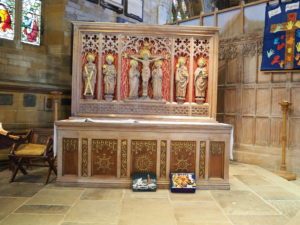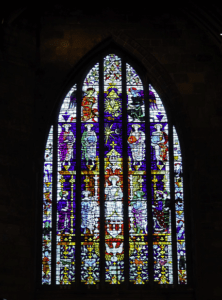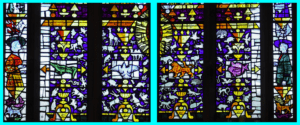St Mary’s with Holy Apostles, usually shortened to St Mary’s Church, is set high above the town, below the walls of the castle. It is surrounded by a large graveyard although many of the tomb stones have been moved to the sides or else used as paving slabs. The grave of Anne Bronte who died in Scarborough, still stands in the small graveyard across the road from the church. The inscription is now much eroded and a slate plaque was placed in front of the grave in 2011 with the original text. This is a scene of pilgrimage for Bronte fans and a copy of her death certificate is displayed in the south aisle of the church, along with a notice explaining the errors in it.
St Mary’s is a big church, reflecting the importance of Scarborough Castle as a Medieval Royal Castle. The church dates from 1150 and, with the castle, is the oldest building in Scarborough. It may have been built by the masons working on the castle, who would have worshipped here. In 1189, King Richard granted the church to the Cistercian Abbey of Citeaux in France.
The church was extended at the start of the C13th when the north and south aisles were added. The Black Death in the mid C14th lead to the wealthy building chantry chapels off the south aisle where priests could pray for their souls. The transepts were built in the mid C14th in the newer perpendicular style. A second north aisle was built which resulted in the roof being raised and blocking the clerestory windows in the north walls. The quire was rebuilt on a much larger and grander scale.
After the Dissolution of the Monasteries, the church became the parish church.
During the Civil War, the castle was a Royalist stronghold, although the Parliamentarians had taken control of the town and the church. They even installed a huge cannon to fire through the the east window which inflicted great damage on the castle keep. The Royalist cannons retaliated and inflicted similar damage on the church. By the time the castle fell, the east end of the church and north transept had been ruined beyond repair. Now only two tall columns of stone next to the road mark the extent of the pre Civil War chancel.
In 1659, the weakened central tower blew down in a gale and had to be rebuilt over the repaired crossing which became the chancel. It is still a large and impressive church, even with the truncated east end.
Inside it is an equally large and impressive building. Some of the round Norman pillars survive in the north arcade. Over the pointed chancel arch is the inscription “come unto me all ye that labour and are heavy ladened and I will give you rest”.
Steps lead up to the small chancel with its C19th wood choir stalls and large organ on the north wall. It is dominated by the east window dating from 1958 which replaced the Victorian window damaged by a German mine in WW2. This is a glorious window with the Hand of God at the top surrounded by two angels. Below, Christ sits in Majesty with the dove of the Holy Spirit at this feet. At the bottom on either side are two modern characters. On the left is a woman with her cat. on the left is a bespectacled man with his dog. Between them are depictions of all God’s living creatures, including a crocodile, lion, monkeys. kangaroo, camel, toad…
The rest of the windows are C19th, including the lovely west window with scenes from the life of Christ.
At the end of the south aisle, behind a glass screen, is the Lady chapel with a simple altar. Along the sides of the south aisle are what used to be chantry chapels. No longer used, the walls are covered with memorials.
That nearest the east end is described as the Anne Bronte Corner and has a small display about her, including her death certificate.
The far north aisle had to be rebuilt after the Civil War. The beautiful reredos standing at the east end is C19th, and according to the leaflet in the church came from Christ Church, the C19th Chapel of Ease. At the centre is Christ crucified surrounded by four of his disciples including St Andrew, St Peter and St James the greater with a scallop shell. Standards hang from the walls of the chapel and the memorial to the Dead of World War One is on the wall. The chapel is also described as the Fisherman’s Aisle and there are two memorials to members of the Scarborough Lifeboat crew.
This is a lovely church and well worth making the effort to visit. There are more pictures “here”:http://wasleys.org.uk/eleanor/churches/england/yorkshire/north_yorkshire/north_yorkshire_two/scarborough/index.html . It is open every day in the summer months, except Saturdays. Entry is either through the west door, or the south porch with room above. There is a small pay and display car park opposite or on street parking. There is a small Fair Trade shop which also serves hot drinks as well s crisps and biscuits. The nearest post code is YO11 1TH and the grid reference is TA 890 504.










